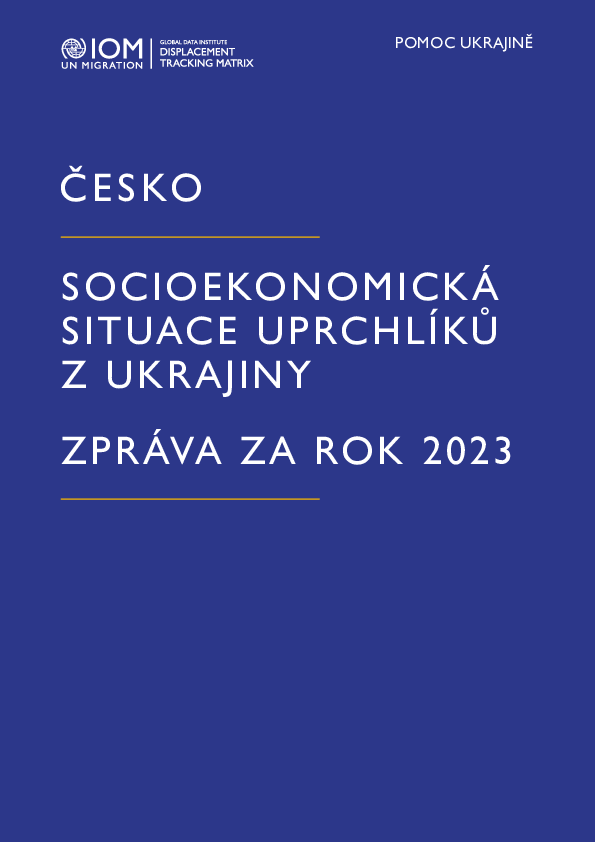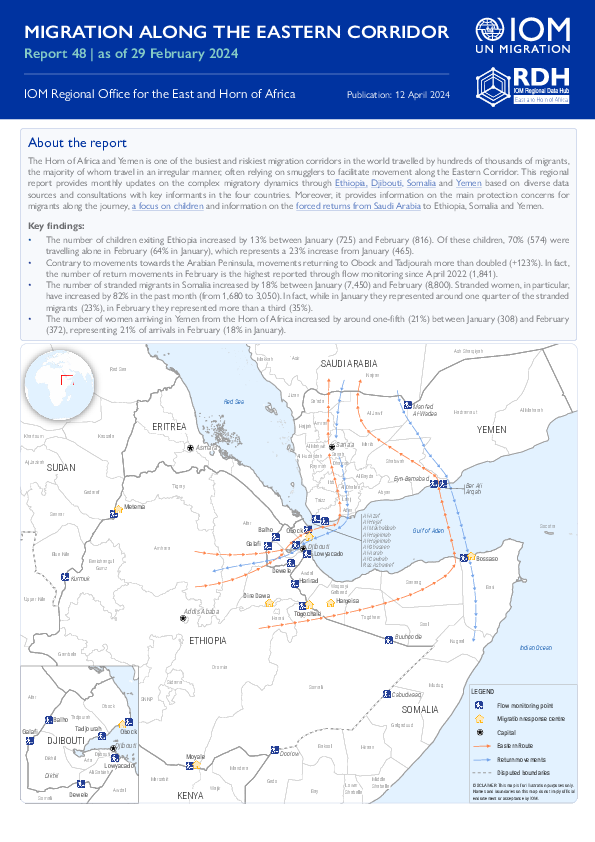-
Countries
-
Data and Analysis
-
Special Focus
-
Crisis Responses

Contact
DTM Uganda, dtmuganda@iom.int
Language
English
Location
Uganda
Period Covered
Mar 01 2024
Mar 31 2024
Activity
- Mobility Tracking
- In March there were reports of affected people due to Heavy Storms or Hailstorms in the districts of Kanungu (8,620), Namisindwa (825), Bunyangabu (580), Buikwe (262), Mubende (40) and Wakiso (25). In Kampala (24) and Bundibugyo (5) were reports of affected people due to fires, while in Buikwe nine people were affected by a transport-related accident.
- The impacts of the hazards affected 10,390 individuals (2,387 households), with 426 people from 91 households were internally displaced. Children below the age of 18 were the most affected age group (67%), followed by adults (18-64) at 30% and elderly above 64 (3%). Notably, more than half of affected people were female (62%).
- Urgent needs identified include sanitation, nonfood items, food assistance among others. Infrastructure damage assessed indicated that 213 houses were partially damaged, 41 houses were completely destroyed, 5 schools, 1 water facility and 1 health facility were affected.

Contact
DTM Haiti, dtmhaiti@iom.int
Language
French
Location
Haiti
Period Covered
Mar 08 2024
Apr 09 2024
Activity
- Survey
- Flow Monitoring Survey
- Flow Monitoring
Since end of February 2024, the security situation has deteriorated in the Metropolitan Area of Port-Au-Prince (MAPAP), the capital of Haiti. In addition to creating displacement within the MAPAP, generalized insecurity are pushing more and more people to leave the capital to find refuge in provinces, taking the risks of passing through gangs-controlled routes. In order to monitor these movements towards provinces and inform appropriate response strategies, DTM has launched data collection at several of the most used bus stations in the capital (see page 5 for more details on the methodology). In one month of implementation of this activity (since 8 March), movements of 94,821 people leaving the MAPAP have been observed (see pages 3 and 4 for more details on their profile). The majority of them (58%) took means of transport heading towards the Grand Sud departments (Grande’Anse, South, Nippes and South-East). It should be noted that this region already hosts more than 116,000 people who had in vast majority, fled the MAPAP in recent months (see the report on displacement in the Grand Sud). Half of flows headed towards 3 main destination municipalities: Jérémie (in Grande’Anse), Les Cayes (South) and Léogâne (West).
It should be emphasized that provinces do not have sufficient infrastructures and host communities do not have sufficient resources that can enable them to cope with these massive displacement flows coming from the capital.
It should be noted that at the beginning of March, when the security situation worsened, people who were already internally displaced (IDPs) were the first to begin leaving the capital. Over time, more and more people who were not IDPs are also leaving: as of 10 March, 86% of people leaving the MAPAP were IDPs. One month later, this percentage dropped to 60%, while almost 40% were those who had never fled their residence and who decide to leave it and seek refuge in provinces. This further describes the deterioration of the situation in the capital, given that leaving the capital could be a relatively quicker decision to make for a person who was already displaced than for someone who was still in their residence and decides to leave it for seek refuge in provinces.

Contact
DTM Nigeria, iomnigeriadtm@iom.int
Language
English
Location
Nigeria
Period Covered
Apr 01 2024
Apr 07 2024
Activity
- Mobility Tracking
- Event Tracking
Between 1 and 7 April 2024, a total of 1,223 new arrivals were recorded at locations in Adamawa and Borno states. The new arrivals were recorded at locations in Askira/Uba, Bama, Chibok, Damboa, Dikwa, Gwoza, Kaga, Kala Balge, and Monguno Local Government Areas (LGAs) of the most conflict-affected Borno State, and in Fufore, Girei, Gombi, Hong, Madagali, Maiha, Michika, Mubi North, Mubi South, Numan, Song, Yola North and Yola South LGAs of Adamawa State.
ETT assessments identified the following movement triggers: family re-unification (407 individuals or 33%), poor living conditions (261 individuals or 21%), improved security (176 individuals or 14%), fear of attack (175 individuals or 14%), military operations (94 individuals or 8%), access to humanitarian services (56 individuals or 5%) and seasonal farming (54 individuals or 5%).

Contact
DTM Burundi, DTMBurundi@iom.int
Language
French
Location
Burundi
Period Covered
Mar 31 2024
Apr 07 2024
Activity
- Mobility Tracking
- Event Tracking
La DTM a identifié 16 182 personnes affectées et 832 personnes déplacées par les inondations, les pluies torrentielles, et les glissements de terrain.
• The number of children exiting Ethiopia increased by 13% between January (725) and February (816). Of these children, 70% (574) were
travelling alone in February (64% in January), which represents a 23% increase from January (465).
• Contrary to movements towards the Arabian Peninsula, movements returning to Obock and Tadjourah more than doubled (+123%). In fact,
the number of return movements in February is the highest reported through flow monitoring since April 2022 (1,841).
• The number of stranded migrants in Somalia increased by 18% between January (7,450) and February (8,800). Stranded women, in particular, have increased by 82% in the past month (from 1,680 to 3,050). In fact, while in January they represented around one quarter of the stranded migrants (23%), in February they represented more than a third (35%).
• The number of women arriving in Yemen from the Horn of Africa increased by around one-fifth (21%) between January (308) and February
(372), representing 21% of arrivals in February (18% in January).

Contact
DTM Burundi, DTMBurundi@iom.int
Language
English
Location
Burundi
Period Covered
Feb 01 2024
Feb 29 2024
Activity
- Mobility Tracking
- Baseline Assessment
IOM’s Displacement Tracking Matrix is a comprehensive system to analyse and disseminate information to better understand the movements and needs of Internally Displaced Persons (IDPs) in Burundi. The baseline assessment aims at providing information on the stock (presence) by colline of IDPs which are categorized into two groups: Internally Displaced Persons (IDPs) including IDPs who returned to their colline of origin but not their home and returnees who became IDPs. The baseline assessment also collects information on the cause of displacement and the type of shelter hosting IDPs. Data collection is conducted four times per year by trained Burundian Red Cross volunteers operating at all administrative levels: provinces, communes and collines.

Contact
DTM Poland, iomdtmPoland@iom.int
Language
Polish
Location
Poland
Period Covered
Oct 01 2023
Jan 31 2024
Activity
- Survey
W marcu 2023 r. IOM Polska przeprowadziła Ankietę Integracyjną, aby ocenić postępy i potrzeby związane z integracją ekonomiczną i społeczną uchodźców z Ukrainy w Polsce. Ocena ma na celu zbadanie zatrudnienia, warunków mieszkaniowych i finansowych oraz więzi społecznych i wyzwań związanych z integracją uchodźców.
W okresie od 1 października 2023 r. do 31 stycznia 2024 r. przeprowadzono łącznie 1371 ankiet. Niniejszy raport zawiera szczegółowy przegląd potrzeb i potencjalnych zagrożeń dla ukraińskich uchodźców w Polsce, którzy mieszkają poza ośrodkami zbiorowego zakwaterowania, tj. tych, którzy są goszczeni w domach prywatnych lub sami płacą za mieszkanie lub dom.

Contact
DTMCostaRica@iom.int
Language
English
Location
Costa Rica
Period Covered
Mar 01 2024
Mar 31 2024
Activity
- Flow Monitoring
- Mobility Tracking
- Event Tracking
Cantons: Alajuela, Alajuelita, Cartago, Desamparados, Escazú, Corredores, Heredia, Los Chiles, San Carlos, San José, Santa Ana, Santo Domingo, Tibás
Costa Rica, like the other countries in the Central American region, has been characterized as a migratory corridor for people who transit by land from the south to the north of America and whose destination is the countries in the north of the continent. This flow on the move through the Americas is mainly made up of people from the Bolivarian Republic of Venezuela, Cuba, Haiti, Ecuador, as well as people from other countries in South America, Africa and Asia.
According to estimations from IOM Costa Rica, during March 36,106 people entered the country, an approximate average of 1,165 people per day and estimating a decrease of 13% compared to February 2024. In addition, 1,178 people stranded in the monitored shelters were identified and 872 people stranded in the public places visited.

Contact
DTM Europe, DTMMediterranean@iom.int
Language
Czech
Location
Czechia
Period Covered
Jan 01 2023
Dec 31 2023
Activity
- Survey
K 31. prosinci bylo v Česku podle vnitrostátních orgánů registrováno 375,021 uprchlíků z Ukrajiny, včetně TCN, kteří požádali o dočasnou ochranu.
Tato zpráva, založená na analýze 5, 010 dotazníkových šetření realizovaných v průběhu roku 2023, vznikla s cílem blíže popsat jejich potřeby, záměry a integrační výzvy, kterým čelí.
Detailněji popisuje následující oblasti: zaměstnání, bydlení, ekonomickou situaci a potřeby respondentů, přičemž zkoumá, jak se situace respondentů měnila v závislosti na délce jejich pobytu v Česku.

Contact
DTM Europe, DTMMediterranean@iom.int
Language
English
Location
Czechia
Period Covered
Jan 01 2023
Dec 31 2023
Activity
- Survey
As of 31 December, according to national authorities, 375,021 refugees from Ukraine, including TCNs, were registered in the Czech Republic and had applied for temporary protection.
The aim of this report, which is based on an analysis of 5, 010 questionnaire surveys conducted during 2023, is to explore their needs, intentions, as well as the integration challenges they face.
The following areas are elaborated on in more detail: employment, housing, economic situation and needs of the respondents. There is also an analysis of how the respondents' situation has changed depending on the length of their stay in the Czech Republic.
